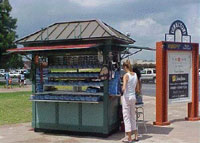Metro exploring retail in rail stations
Metro officials plan to solicit proposals from potential vendors to operate retail kiosks in at least twelve Metro stations, according to a presentation they showed the Riders’ Advisory Council last night. The plan is in its very early stages, but staff have identified a set of stations that have high enough ridership to potentially support retail, but also have enough space for at least one vending cart.
The proposed locations include the sidewalks outside Anacostia, Fort Totten, Branch Avenue, Glenmont, New Carrollton, Shady Grove, and West Falls Church; the Kiss-and-Ride at Branch Avenue and the short-term parking area at Vienna; areas inside the station but outside the faregates in Gallery Place, King Street, and Rosslyn; and inside the paid area of Gallery Place, Metro Center, and Vienna. Some stations include multiple potential locations, and Metro is also open to bidders suggesting other locations as well.
Since Metro prohibits eating in stations and on trains, the retail carts won’t serve coffee, bagels, or other food that people might eat during their trip. Metro did issue an RFP in May of 2006, but which prohibited any sales of food, beverages or tobacco, but received no satisfactory proposals. This RFP will allow packaged food and drink but will still prohibit tobacco. Cynthia Jachles, who is managing the project, is waiting to see what bidders suggest, but believes that in addition to non-food items, vendors could sell packaged food such as take-home dinners or lunches for riders to buy as they exit Metrorail.
RAC member Frank DeBernardo also suggested Metro reach out to the U.S. Postal Service, as his commute by bus and train from Greenbelt to Virginia does not pass by any post offices. Many riders might find it convenient to mail a letter or buy stamps while waiting for the train. Other members including Fairfax’s Evelyn Tomaszewski worried that despite the restrictions, this program might increase eating and drinking on Metro, which is still fairly common despite the rules.

Potential retail location at King Street.
Jachles, who previously worked on retail concessions for New York City, talked with many other transit agencies about their experiences. Chicago and San Francisco, which also prohibit eating and drinking on their transit systems, have successful retail kiosks in some of their stations. Also, police officers in at least one other city feel that vendors have improved safety by adding “eyes on the street.”
Metro hopes to find one “master licensee” who can operate at least one kiosk at all twelve stations. That will ensure that retail serves all jurisdictions and simplify enforcement, such as cleanliness. However, Metro is open to individual vendors submitting proposals for single locations, either at one of the twelve stations or somewhere else.
Several RAC members, including Sharon Conn of Prince George’s and DC’s Carol Carter Walker, asked whether the Master Licensee system would cut out opportunities for small, local and/or minority businesses to participate. While they can still submit bids, the Master Licensee might be able to take the most profitable spots. On the other hand, at this point Metro doesn’t even know whether a vending program will work or how much revenue they can earn. Retail is a very low-margin business, and it’s possible that only a larger operator will be able to run concessions in Metro stations at all.
In fact, suggested RAC Chair Diana Zinkl, it’s possible that one or two locations at twelve stations is not even enough. She pointed out that the areas around many stations, even denser, more urban ones like Bethesda, lack places for someone to buy food or other items when exiting the system to go home or visit a friend. Perhaps a “critical mass” with more vendors in one location would actually draw more traffic and increase the opportunities for success, she said. Some other members echoed a desire for more vendors in more locations. Kelsi Bracmort of DC suggested Metro investigate ways to let riders pay for items with their SmarTrip cards.
According to Jachles, the Metro board will make these decisions, including whether to prefer a Master Licensee or more individual vendors, how many vendors to place at each station, as the program evolves. The Board will review this plan on May 28th, but will know much more once they receive proposals. If they get a lot of individual vendor bids, Jachles explained, they can decide whether to accept those over a Master Licensee. They’ll also know the tradeoffs, such as whether food vendors offer more revenue to Metro, and can decide whether to take more of increasing eating on trains if the revenue would cover added cleaning staff.
Hopefully, Metro will also enable the RAC and other members of the public to see more information about the bids, so we can advise the Board on the best course of action. Ultimately, adding retail options could significantly help riders, especially those like DeBernardo who commute between stations with few or no other retail options, and bring in more revenue for Metro as well. Metro staff also decided to present this plan to the RAC very early in its evolution, which provides more opportunities for input. Other departments should follow this project’s example.

